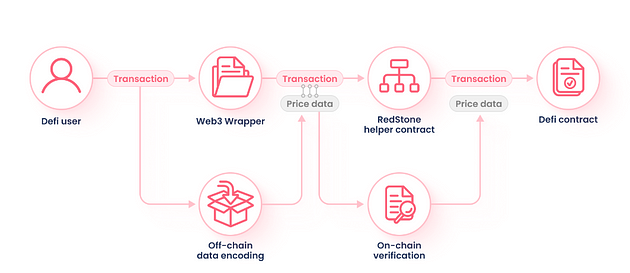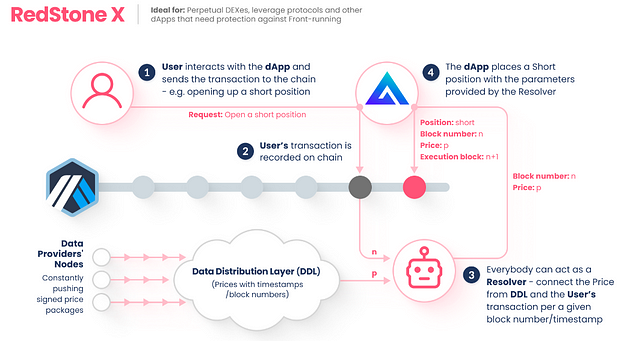REDSTONE -Modular Oraclestailored to your dApp
RedStone is an Oracle that delivers frequently updated, reliable, and diverse data feeds for your dApp and smart contracts on multiple L1s & L2s.
Why we build another Oracle system
- Pushing data on-chain regardless of whether it is used or not is a huge waste of resources
- Obsolete and monolithic architecture limits scalability (it’s hard to list new assets or reduce latency)
- Protocols cannot fully decide on trusted sources and data update conditions
- End-users are fully dependent on relayers and could be cut off from the service
Solution
RedStone offers a radically different design of Oracles catering to the needs of modern DeFi protocols.
- Data providers can avoid the requirement of continuous on-chain data delivery
- Allow end users to self-deliver signed Oracle data on-chain
- Use the decentralized Streamr network to deliver signed oracle data to the end users
- Use token incentives to motivate data providers to maintain data integrity and uninterrupted service
- Leverage the Arweave blockchain as cheap and permanent storage for archiving Oracle data and maintaining data providers’ accountability
Key facts
- The modular architecture maintains data integrity from source to smart contracts
- There are 3 different ways to integrate our service tailored to your needs
- We provide feeds for more than 1000 assets integrating ~50 data sources
- We are present on 20+ chains
- RedStone has been supporting DeltaPrime since March 2022 and has been live on mainnets since January 2023. Our code was audited by multiple security experts including ABDK, Peckshield and L2Beat Co-Founder.
- RedStone was a launch partner for DeltaPrime on Avalanche and delivered data feeds not available anywhere else. Thanks to that DeltaPrime became the top 3 fastest growing dApps according to DefiLama.

Modular design
Putting data directly into storage is the easiest way to make information accessible to smart contracts. This approach used to work well for large update intervals and small number of assets. However, there are more and more tokens coming to DeFi and modern derivative protocols require much lower latency boosting the maintenance costs of the simple model.
That’s why, RedStone proposes a completely new modular design where data is first put into a data availability layer and then fetched on-chain. This allow us to broadcast a large number of assets at high frequency to a cheaper layer and put it on chain only when required by the protocol.
3 Ways to integrate
Depending of the smart contract architecture and business demands we can deliver data using 3 different models:
- RedStone Core, data is dynamically injected to user transactions achieving maximum gas efficiency and maintaining a great user experience as the whole process fits into a single transaction
- RedStone Classic, data is pushed into on-chain storage via relayer. Dedicated to protocols designed for the traditional Oracles model, that want to have full control of the data source and update conditions.
- RedStone X, targeting the needs of the most advanced protocols such as perpetuals, options and derivatives by eliminating the front-running risk providing price feeds at the very next block after users’ interactions
Data Flow
The price feeds come from multiple sources such as off-chain DEX’ed (Binance, Coinbase & Kraken, etc.), on-chain DEX’es (Uniswap, Sushiswap, Balancer, etc.) and aggregators (CoinmarketCap, Coingecko, Kaiko). Currently, we’ve got more than 50 sources integrated.
The data is aggregated in independent nodes operated by data providers using various methodologies (eg. median, TWAP, LWAP) and safety measures like outliers detection. The cleaned and processed data is then signed by node operators underwriting the quality.
The feeds are broadcasted both on the Streamr and directly to open-source gateways which could be easily spun off on demand.
The data could be pushed on-chain either by a dedicated relayer operating under predefined conditions (ie. heartbeat or price deviation), by a bot (ie. performing liquidations), or even by end users interacting with the protocol.
Inside the protocol, the data is unpacked and verified cryptographically checking both the origin and timestamps.
Data Format

RedStone Classic works
This approach is built on top of the RedStone Core model maintaining the security of on-chain validation of data providers and timestamps.
The model consists of two main parts. The first one is the off-chain relayer responsible for pushing data on-chain in a customized way using environment variables. The second part is the on-chain contracts which enable storing prices and getting them through a familiar interface (e.g. the Chainlink Aggregator ). RedStone Classic can be used on all EVM-compatible L1s & L2s + Starknet + Fuel Network.
RedStone X
An eXtreme protection against front-running
The model implements a Deferred execution pattern where transactions are processed in two steps:
- A user initiates the transaction by recording on-chain an intention to interact with the protocol (ie. open a perpetual position) without knowing the exact context (ie. price) in which the transaction will be executed. This mitigates any attempts to arbitrage the protocols by front-running price delivery from Oracles.
- The price is pushed on-chain only in the second step, which usually happens at the very next block. Anyone (including the user himself) could push the price, as its integrity is validated on-chain based on the protocol constraints. Such a price will be used to finally settle the transaction.
This model was popularised by perpetual protocols such as GMX and it enables a new wave of super-efficient DeFi projects that are rapidly growing despite the bear market.
Tokenomics
Usage of the token
Tokens have proven to be a very useful tool for achieving coordination in distributed systems and aligning the incentives of various actors. RedStone facilitates a data-sharing ecosystem by incentivizing participants to produce, publish, and validate data in a continuous and diligent way.
Data access fees
The end users who benefit from access to valuable information use tokens to reward providers that published this data. The exact fee and the subscription terms are at the discretion of the provider and depend on their effort, demand for data and potential competition.
Locking
Every provider needs to publish a Service Level Agreement describing the scope of data being served, the source of information, and the frequency of updates. In the event that a provider breaches the terms of service, there will be a penalty applied that is also denominated in tokens. To reassure users that any future claims will be fully covered, providers must set aside a certain number of tokens and lock them for a set period of time. These funds are locked in the ecosystem and are an important factor for users when selecting the most reliable provider.
Dispute resolution
Because of the diverse nature of the provided information, it will not always be possible to decide if data was corrupted. Therefore, it will be necessary to have a fallback procedure to resolve any disputes about the data quality. The process could be facilitated by tokens, where juries will be rewarded for voting with the majority and punished for supporting the losing side.
Bootstrapping the market
At the early stage of development, the token could be distributed to providers to reward their availability and bootstrap the market before there is enough demand from data users.
RedStone is Launching Expedition
- by RedStone
- October 31, 2023
Welcome to the RedStone Expedition — an extraordinary odyssey that invites adventurers to journey through a landscape rich with challenges, innovation, and rewards. It’s spanning 3 immersive seasons, each lasting 2–3 months.
We value your hard work and participation. In this adventure, your effort will guide you to fantastic discoveries and rewards at the end. Everyone is invited to join, find hidden treasures, and experience the exciting parts of this journey.
RedStone Gems (RSG): The Heart of the Expedition
RedStone Gems (RSG) are the most important part of the Expedition. They are activity points that are fully stored on the blockchain. Every part of a user’s transaction history, point calculations, and the verification of the RSG points system is securely kept on the Arweave blockchain using Warp Contracts SDK technology.
These gems are super important in the final stages of the Expedition. They are used as a universal way to measure how engaged participants are, and they help in giving out rewards fairly to users based on their involvement.
Earn RSG in a variety of ways:
- Engaging on the RedStone Discord server
- Participating in community campaigns, such as those involving Galxe
- Joining the RedStone Miners Ambassador Program
- Collaborating in on-chain activities with RedStone partners
- Creating valuable content centred around RedStone
- Actively participating in RedStone initiatives, both online and in real life (IRL)
In addition to earning points, you can get special boosts that will help you collect points even faster! These boosts are given for having certain roles on Discord, like Early Miner, Vein Master, GR-15, and others, or for owning specific NFTs related to the Expedition. Boosts stack up and act like multipliers for the points you earn, allowing participants with boosts to collect RSG points more quickly. However, keep in mind that boosts don’t apply to all activities.
Boosts stack up and act like multipliers for the points you earn, allowing participants with boosts to collect RSG points more quickly. However, keep in mind that boosts don’t apply to all activities.
Dashboard: Your Personal Expedition Tracker
A special dashboard is available to help you keep track of your progress during the Expedition. You can log in using your Metamask wallet, and more wallet options will be added soon.
Once logged in, the dashboard shows your current RedStone Gems (RSG) status, recent points earned, and any active boosts you have. It’s the heart of the Expedition, acting as a central hub where you can find all important information.
Throughout the Expedition, there will be overall and seasonal rankings. Top participants will receive special rewards like NFTs and extra RSG points at the end of each stage.
Remember to connect your Discord account to earn points for being active on the RedStone server. You can do this easily with the help of the Warpy bot.
Warpy: Bridging Discord and Blockchain
Warpy is a part of the Warp Contracts project and helps track activity on the Discord server. To earn points for your Discord activities, you need to connect your EVM address to your account. If you don’t, your wallet won’t receive points. Here’s how to do it:
- Join the RedStone server on Discord.
- Find the channel named Warpy.
- Connect your wallet by using the
/linkwalletcommand.
By doing this, your activity on the server will be rewarded with RedStone Gems (RSG).
Partnerships: A Pillar of the Expedition
Partners play a crucial role in the Expedition. They are essential for awarding RedStone Gems (RSG) points. We will have special weeks dedicated to specific partners, allowing participants to get to know them better. As the Expedition progresses and new seasons unfold, we will reveal more partners who are joining the journey.
Roadmap
31.10.2023: Start of the Expedition
Season 1: Rest of the year & Beginning of the next year.
Season 2: First half of 2024
Season 3: Second half of 2024 As we move through the Expedition, we’ll unveil new chances and options for participants, making the journey even more exciting. Remember, the earlier and more consistently you participate, the more points you’ll earn, as the points for activities will decrease over time.
As we move through the Expedition, we’ll unveil new chances and options for participants, making the journey even more exciting. Remember, the earlier and more consistently you participate, the more points you’ll earn, as the points for activities will decrease over time.











































![[LIVE] Engage2Earn: auspol follower rush](https://cdn.bulbapp.io/frontend/images/c1a761de-5ce9-4e9b-b5b3-dc009e60bfa8/1)

![[ℕ𝕖𝕧𝕖𝕣] 𝕊𝕖𝕝𝕝 𝕐𝕠𝕦𝕣 𝔹𝕚𝕥𝕔𝕠𝕚𝕟 - And Now What.... Pray To The God Of Hopium?](https://cdn.bulbapp.io/frontend/images/79e7827b-c644-4853-b048-a9601a8a8da7/1)










